
CHAPTER 2
WORKING IN THE
RUM
FACTORY

A purist vision of rum might be something like this:
Rum is a combination of:
• the essence of sugarcane
• the power of the molasses that’s left over from transforming cane into sugar
Now since rum made its way out into the world in wooden casks on wooden ships, it’s not unreasonable for a purist to add that rum is also:
• the spirit of the wood that carried it around the world
Not a bad little purist bundle there—a raw plant, a neglected by-product, and an earthy, renewable, reusable container transformed by craftsmen into a little flavor factory.
A modernist vision might be something like this:
Alcohol is an incredible solvent of flavorful compounds. If we can get that solvent already loaded with a cargo of flavors of its own—especially flavors from the mythic, iconic, tropical sugarcane—we can probably use that as a canvas on which to paint a million other great flavors.
As you can imagine, the purists and the modernists, while they may have great respect for each other, rarely work in the same kitchen, winery, brewery, or distillery. So going to work in a rum factory required a choice: purist or modernist/tradition or innovation. There was one more distinction to watch out for: industrial or craft distilling? I decided to go for craft.
So what is craft distilling? To find out, I went to work for a few days as the most unskilled laborer in one of the premier craft distilleries in the United States. Dogfish Head is best known as an edgy, artistic, and totally modernist brewery. Their ales rarely fit the classic style descriptions that most beer lovers use to navigate the world of beer, and for that bit of eccentricity they have come to be widely respected and loved.
Dogfish Head
You may have heard about the revolution in beer. In the last thirty-five years, thousands of new breweries have opened, all of them dedicated to the idea that beer should taste good. If you weren’t around before this revolution, that idea may seem so commonplace as to be not worth stating. How else should beer taste if not good?
The story has been told elsewhere—consult my book, Short Course in Beer, for details—but emphatically, this was a revolution created mostly by purists. The brewers who remade our notion of beer did it by returning to traditional beer recipes and allowing the flavor of beer to reemerge.
There were a few modernists—a few quirky souls who looked at the brewing process and thought that there was a tremendous potential there to create some kick-ass, world-changing, ultra-sophisticated, beguiling, and intriguing tastes. One of the modernists was Sam Calagione, who founded Dogfish Head—a high-tech, ultra-modern brewery in Delaware—and startled the beer world with brews that contained grape juice, spices, apples, raisins, herbs, citrus peel, honey. Nothing tasted traditional and everything tasted great. You couldn’t write a book about the beer revolution without mentioning Dogfish and Calagione, and I didn’t.
In one of those great synchronicities, it turns out that Dogfish Head is now making rum. It’s no surprise that their rum is wildly modernist. The final flavors are up for grabs: no cow is too sacred to be fermented and distilled. What’s truly surprising is that the distillery is about as old-fashioned and high-touch as it’s possible to get. If as a wine-lover, you enjoyed the “garagistes” or if you once swapped bootleg mix-tapes of your favorite bands, you’ll get the idea.
Before I take you into the Rum Factory to get your hands dirty and your palate fatigued, maybe we should pause for a brief philosophical note.
Dualism
“In each age of the world . . . will be found some profound outlook, implicitly accepted . . . almost too obvious to need expression, and almost too general to be capable of expression. [It], like the air we breathe, is so translucent, and so pervading, and so seemingly necessary, that only by extreme effort can we become aware of it.”
—Alfred North Whitehead
Dualism is a theory about the universe, kin to one of those profound outlooks that Whitehead is talking about in the paragraph above. Dualism holds that the world is made up of two elementary categories. Good and evil, mind and body, form and matter, us and them, universal and particular are examples of dualistic categories. Even though the term itself was first used in the nineteenth century, dualistic theories date back to the ancient world.

Plato and Aristotle, dualists, from Raphael’s The School of Athens.
Dualisms maintain that the two categories are mutually dependent on each other and that both are necessary in the world.* Platonism, Aristotelianism, and Christianity are schools of thought based on dualism.
A major problem faced by dualists is explaining how the two realms connect. How do the mind and body relate to each other? Does the universal give rise to the particular? The difficulty involved has led many thinkers to adopt a mechanical, monistic view of the world. Scientists, for example, may deny the existence of any realm other than the purely physical. Mental and spiritual matters are reduced to brain states which are, of course. physical. Dualism disappears in the process. The utility of this kind of thinking has done a lot to advance monism as the foundation of our day-to-day modern thinking, even if we mostly remain sentimentally dualists.
In spite of the philosophical problems, some thinkers have struggled along with dualism, proposing various connections. The most persistent dualism in the western world is one that puts Mind, Spirit, and Goodness on one side and Physical Appetite, Body, and Evil on the other.
It’s hard to read any western religious literature without being reminded of this distinction.
Mortify the body, purify the soul. You can see this dualism reflected in the architecture of churches which remind the worshipper with their vaulted ceilings that God is great and she (the worshipper) is very small.
Spirits are the “light,” alcoholic, spiritual fraction of a liquid, lifted away from the gross, material fraction to which they were bound. The distiller is a liberator, a transformationalist. The moonshiner is merely separating gold from gravel, wheat from chaff.
The Wash
Returning to the industrially safe and legally-sanctioned world: Rum making at Dogfish begins in their brewpub brewery, where molasses is diluted and sanitized with very hot (160°F/71°C) water and pumped into a fermenter. The yeast that’s added is called distillers’ yeast—it’s a muscular, turbocharged, no-nonsense sort of organism that produces a lot of alcohol in a short time and doesn’t contribute much flavor of its own. Two or three days later, the result is a 10 percent alcohol molasses drink (shall we call it sugarcane beer? Molasses wine? The folks who work there call it the “wash.”)
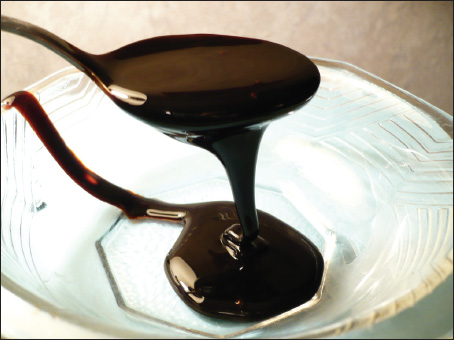
Luscious molasses. Photo by Badagnani.
Breweries are scrupulously clean places where controlling the act of fermentation is the name of the game. The brewer ferments his beer and that’s his product. The wash is not a final product, it is an intermediate step on the road to rum and its production could be pretty casual. It’s fair to say that a wash produced in a brewery is about as controlled and watched-over a wash as you could get. At Dogfish, it’s fermented with the same fussiness that’s applied to the beer.
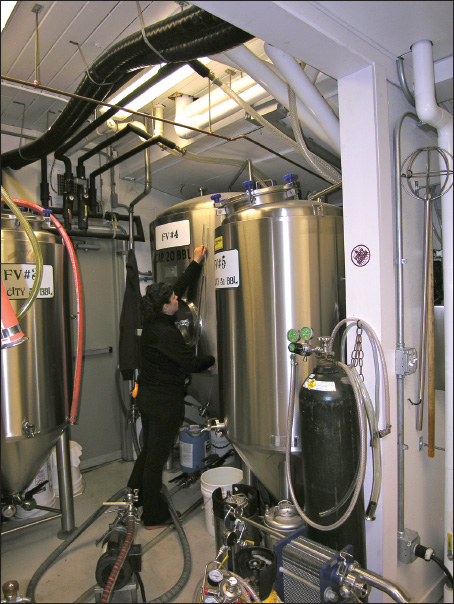
Stainless steel fermenters at Dogfish Head.
The fermentation is carried out with the final flavor of the rum in mind. For strongly flavored rums in Jamaican rummeries, wild yeasts and bacteria may be introduced which convert some of the sugars to acids, esters, and fusel alcohols. “Cleaner” rums start out with single-strain yeasts and may have some cane juice added to reduce the amount of cane debris or ash. The cane juice, if it’s fresh, may also contain other yeasts that add to the complexity of the flavor.
This liquid is pumped out of the brewery and upstairs into holding tanks in the small distillery that perches above the Dogfish Head’s brewpub.

In the days before carefully-bred and packaged turbo-yeasts, dunder was the source of the ferment. Dunder is the yeast-rich bubbling froth from a batch of rum. It was harvested to start the fermentation of a second batch. Dunder is the traditional yeast source in Jamaican rum.
Dunder is more than just yeast. It includes the yeast nutrients in the protein derived from dead yeast cells. In the old days, excess dunder would be used as fertilizer or sold as animal feed.

Unlike the beer that gets distilled into whisky or the wine that becomes brandy, the wash from the molasses doesn’t taste very good. The kindest thing I can think of to say is that it’s earthy. Yeah, that’s a good word: Earthy.
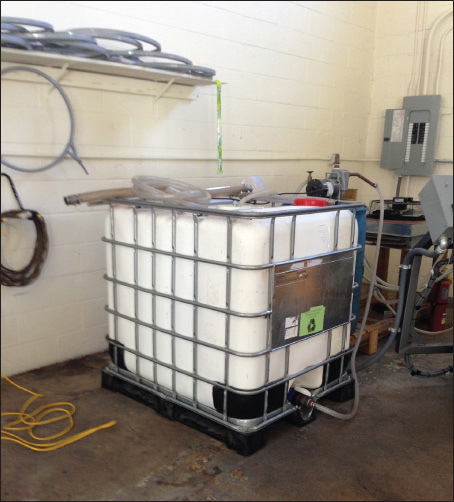
Modern container for shipping molasses.
Distilling
Work begins in the morning where 90 gallons of wash are transferred over into a stainless steel pot still. (The conical top of the still is a recycled hopper from a grain silo that was bolted onto a steam jacket and fitted with pipes and hatches. The Dogfish distillers call it the Frankenstill.)
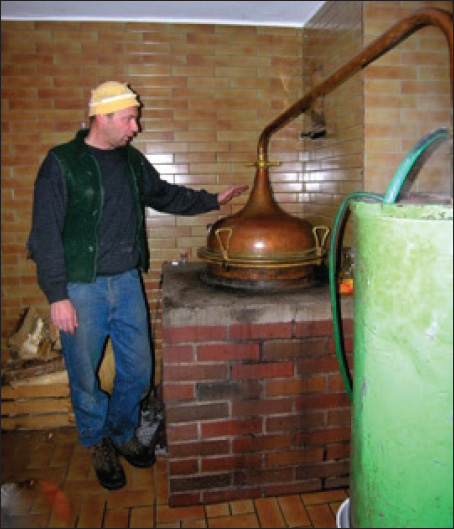
A hand-hammered copper pot still in Austria.
The steam jacket under the still brings the temperature up and the vapors rise to the top of the pot and are led through a tube into a coil. The coil passes through a cooling water jacket (itself made from two beer kegs welded together). At first the vapor is mostly alcohol with a little water. As the distillation run progresses, the temperature rises and more water vapor makes the journey up into the cooling coil.
The vapors condense as they’re cooled and they run out through a nozzle (called a parrot) that incorporates a little well. In that well, there’s a measuring device—a hydrometer—which is just a float that tells how dense this condensed vapor is. Alcohol is less dense than water and so density is a good way to measure the amount of alcohol in a water/alcohol mix. Reading the hydrometer lets the distillers know when the distillation run is producing a smaller amount of alcohol.
When the alcohol yield diminishes, the heat’s turned off and the remaining sludge is discarded. This first distillation is called the stripping run: most of the alcohol has been stripped out of the wash, but the product in the holding tank is a long way from being rum or even from being drinkable.

Water is one-and-a-quarter times denser than alcohol. If you throw a float in alcohol, it sinks deeper than the same float would in water. In mixtures of the two, we can tell what the proportions are just by looking at a calibrated float and seeing how high it rides. The more water in the mixture, the higher the float.
The day’s work at Dogfish produces about thirty gallons of distillate at about 90 percent alcohol (180 proof). It’s a pretty nasty product with traces of methanol (so-called “wood-alcohol”) and a harsh, petrochemical aroma. If you’ve ever been unfortunate enough to smell moonshine, you know what I mean.
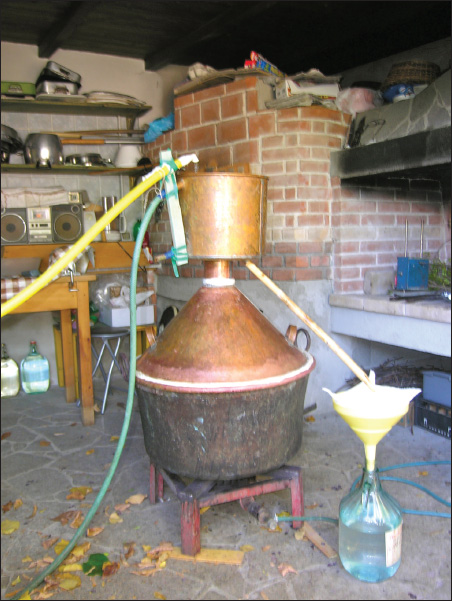
A hand-made still in Sardinia, Italy.
The next day, the liquor from the stripping run is fed back into the clean still. At about 173°F, alcohol vapors begin to escape the mixture. The first vapors are called the heads and they contain most of the methanol and a lot of the harsh flavors. They’re separated out and at least one of the distillers carefully tastes drops of the heads until the flavor becomes cleaner, more like molasses. Now the distillate is real rum. This heart of the distillation is collected and moved to a storage barrel. When the temperature of the vapor rises and the alcohol level in the distillate drops, the flavor changes again. The earthier end of the distillate, the tails, is also separated out.

Checking levels at Dogfish Head.
So far, so purist. What we have is a carefully curated version of fermented molasses. At some distilleries, this would go into wooden barrels; at others, it might be distilled again and filtered to remove most of the molasses flavors. At Dogfish, this new rum is the heart of a new recipe. You can buy some of this pure essence of molasses, but you’ll have to go to the distillery in Rehoboth, Delaware, to pick it up. Dogfish is betting on the modernists and it’s not distributing this rum.

Careful tasting is the best quality control.
There are two small-batch rums that they are distributing, with the distillery’s descriptions:
Dogfish Head Brown Honey Rum is a double-distilled amber rum made with Delaware wildflower honey and aged on American oak chips. Dark and smooth, this rum has a subtle woody character from the oak aging and a touch of sweetness from the honey.
Sounds a bit like bourbon doesn’t it? Or at least something that would appeal to a purist lover of American wood-aged spirits?
The second rum is:
Dogfish Head Wit Spiced Rum. It is a triple-distilled rum aged on Curacao orange peel and coriander. This is a refreshing citrus rum that starts with a note of spiciness and ends with a citrus character.
If you’ve been drinking your beer like a good citizen, you’ll probably recognize the orange peel and coriander as the delicious additions to white beers like Hoegaarden. What’s this rum for? Well the serving suggestions include: mixed drink, soda, or Dogfish cocktail. So we have a rum that evokes the flavors of a popular beer and it’s being mixed with soda . . . hmm . . . sounds like some creeping modernism to me.

New rum is sometimes treated to remove some of its character. It can be filtered through carbon granules to remove some flavor, it can be chilled and filtered to clarify it, and, of course, different batches can be blended together, coloring—in the form of caramel—introduced, and even (gasp!) flavors added.
Aging
Raw distilled spirits taste terrible. This happens because the odd products of fermentation (the congeners like acetaldehyde and the dreaded methanol) along with the volatile substances in the original fermented liquid are transferred to the distillate and concentrated by the removal of water during distillation. These harsh chemicals not only affect the taste of the spirit, they are associated with hangovers and other medical ill-effects of alcohol. They can be tamed in several ways.
Some spirits are redistilled. A second distillation that leaves the early vapors (the heads) and the last ones (the tails) behind will be higher in alcohol and lower in congeners. The three Xs you may have seen on the side of cartoon liquor jugs was a sign that the liquor inside had been distilled three times and was therefore presumed to be purer.
A more direct approach is filtration. The spirits are passed through a column of activated charcoal which absorbs the impurities. Most premium vodkas are filtered as are America’s most famous sour mash whiskeys. In countries where home distillation is legal or tolerated, the simple equipment for the process is easily available to hobbyists.
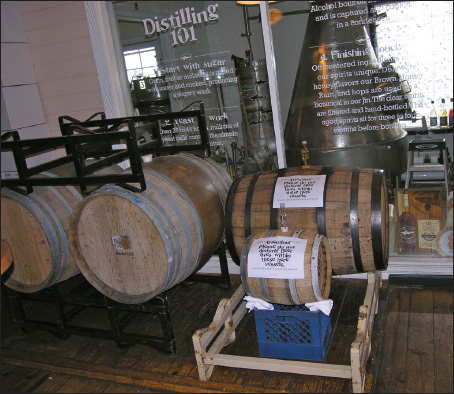
Smaller barrels impart their flavor in less time.
The most romantic—and expensive—process is barrel aging. Most premium brands of spirits that are distilled at low-proof undergo a period of barrel-aging. Putting spirits in a barrel creates some of the same changes that wood-aged wine undergoes: concentration by evaporation, addition of caramel and vanilla flavors, and oxidation of more volatile components. Bourbon and rye whiskey are required by American law to age in new, charred oak. Most spirit barrels have been previously used for wine or bourbon, so the tannic, oaky taste that you may associate with bourbon whisky or wood-aged wine has been extracted and rarely shows up in spirits.
There is no world-wide agreement about how rum should be matured, and rum is aged in many kinds of facilities and locations and for varying lengths of time. Rum can be bottled straight from the still with little or no aging or it can be aged up to thirty years in different sorts of wooden barrels. Rum can be found aging at sea level in St. Croix or thousands of feet up in the mountains in Nicaragua. In the Cayman Islands you can even find it aging underwater, presumably next to other liquid assets that are traditionally sequestered in the Caymans.
A Digression
In 1892 James Monahan, an immigrant’s son in upstate New York, finished his apprenticeship as a cooper—a barrel-maker. As odd as that may seem to us, barrel-making looked like a pretty secure skilled trade for an ambitious young man.
Most things that were shipped were shipped in barrels. Barrels were the ideal container: their curved outlines made them strong enough to withstand the abuses of loading, they were watertight and relatively light compared to what they could contain, and they could be rolled and an experienced dock hand could rock one into an upright position with a few graceful pushes.
Barrel-making was a skilled craft. The skill was in short supply and the demand seemed infinite. What could go wrong?
Five years later, metal barrels were being mass-produced. They lasted longer than their wooden predecessors and cost about the same to make. Coopers preceded buggy-whip makers as the new century’s first technologically unemployed.
James went on to become a cabinet-maker. His grandson eventually wrote books about wine and beer and spirits aged in—can you believe it—wooden barrels.
Bourbon Barrels?
However, one pretty constant aspect of rum aging is the widely accepted art of maturing the rum in once-used bourbon oak barrels. This is the common method of aging used by most rum producers as well as by producers of other spirits today. So why is it that rum is aged in used bourbon barrels? In 1964, the United States Congress recognized bourbon whiskey as a “distinctive product of the United States.” In the resolution it states that: “Among the standards of identity which have been established are those for ‘scotch whisky’ as a distinctive product of Scotland, manufactured in compliance with the laws of Great Britain, Canadian whisky is made in compliance with the laws of Canada, cognac in compliance with . . .” (by now, you get the idea)
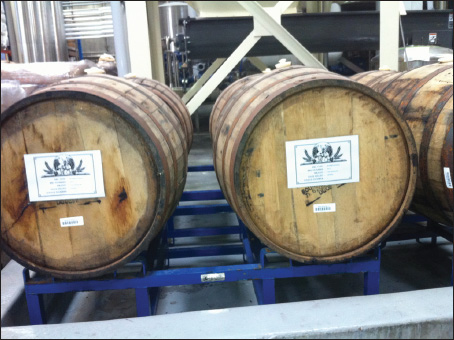
Barrel aging.
So bourbon should be manufactured in accordance with the laws of the United States. And Congress got to work establishing those laws. One of them was that bourbon had to be aged in new, charred, white oak barrels.
As a result of this law, bourbon producers found themselves with a glut of used oak barrels and some vitality returned to the American cooperage industry. Some of these barrels had only been used for the minimum two years required by law to qualify the distilled spirit as American bourbon. Rum distillers (and other distillers and packagers) all over the world were only too glad to acquire as many of these barrels as they could get their hands on. Not only would the bourbon distillers be helping the rum distillers, it was also a way of keeping their own costs of aging their whiskey down. Today, these barrels are also used by producers of high quality beer and there’s scarcely a brewer worth her hops who doesn’t have at least one “bourbon-aged ale.”
Whiskey extracts the most color and flavor out of the barrel in its first use. The predominant flavors extracted from the barrel are vanilla and caramel. You can’t restore the new wood character to a used barrel, but you can certainly re-char it and the caramel flavor is produced mainly from the charring of the oak.
To make a barrel the American oak is cut into staves which are super-heated and bent into ovular form. The barrel is then “toasted” by sending it through a small fire for about twelve minutes to caramelize the sugar in the wood. Next, it is applied to a larger fire for six to twelve seconds to burn out the inside and produce a charcoal layer. The charring has to cover the inside of the barrel evenly so as to provide a consistent flavor to the whiskey. The larger rum producers will receive their oak barrels broken down into bundles and have their team of coopers rebuild and re-char the barrels. The smaller companies will receive their barrels in one piece and begin using them usually after a short curing process to ensure the barrels have not dried out during transport.
During the years of slow aging, the rum is said to “breathe” in the barrel. With fluctuations of temperature, the rum expands and contracts in and out of the oak barrel. This expansion and contraction of the whiskey through the caramelized layer of charred wood inside the barrel mellows it, giving it the distinctive flavor and appearance. This maturation of the whiskey happens quicker in the bourbon belt of Kentucky than it does in the cool, damp climates of Scotland and Ireland but more slowly than in the (typically) warmer climes where rum is made. A ten-year-old rum has acquired the sophistication and polish of at least a fifteen-year-old scotch. (Incidentally, this accelerated maturation is one of the reasons that beautiful rums can be had for less than comparable liquors.) The rum moves about 20 mm in and out of the one inch plus (30 mm) thick white oak, thus drawing out whatever wood flavors were left behind after bourbon aging as well as the caramel of the char.
Another result of the whiskey aging for many years in the oak barrels is that it draws many of the original flavors from the wood, but can leave behind traces of the original bourbon. In many of today’s aged rums you will be able to taste slight hints of bourbon, some more than others depending on the age of the barrel it was aged in. Rum distillers may make up for the diminution of fresh oak (vanilla) flavor by adding wood chips or bits of discarded oak barrels into the aging rum. This provides more oak contact for the rum to draw more color and flavor.
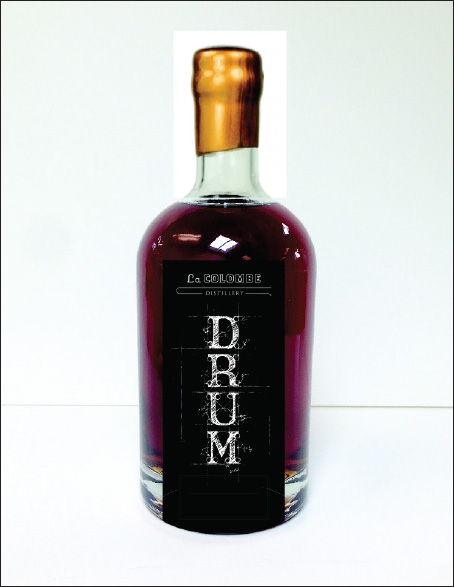
Drum.
And yes, alas, size matters. The smaller the barrel, the more contact the rum will have with the oak. The larger the barrel, the less contact with the oak. Most rum producers use a standard size barrel, around fifty-two gallons (195 liters). Others use smaller barrels for a quicker flavor transfer or huge oak vats which generally take longer to age their rums. These larger vats tend to be favored more by the French islands, for example, Barbancourt Small, artisanal rum distillers in the United States lean toward smaller barrels to hurry the process along and intensify the flavor.
All rum when it is distilled is completely colorless (no coloring agents vaporize to go up alongside the alcohol in the still). The taste is raw and penetrating. The longer the rum is aged in the barrel the darker and smoother the rum will become. Many white rums these days are aged for extended periods of time and then filtered through carbon to remove any color gained during the aging process, but leaving behind all the added flavors. For dark rums, a standardizing dose of caramel is often added to the final blend to ensure uniform color.
The Angel’s Share
When rum is aged for long periods of time in an oak barrel it will slowly evaporate. This evaporation is often called the angel’s share. The evaporation rate is said to be as high as 10 percent. In dry climates, water is more prone to evaporate and the aged liquor is therefore higher in alcohol. Damper aging environments encourage evaporation of alcohol and the proof is therefore lower. While the action of expansion and contraction in the oak barrel adds flavor to the rum, the concomitant evaporation is expensive and adds to the cost of aged rum: there’s simply less of the product after ten years than there was at five.
Another method of aging rum that is most often employed by rum producers in Spanish speaking countries is called the solera method. Solera aging is really a process of aging and blending which muddies the question of the exact age of a rum. A solera consists of a stock of rum (or sherry or vinegar or wine) in oak barrels, divided into ranks of different maturation ages, each of equal volume. The final stage of finished rum is called the solera and the earlier ranks are the criaderas. Rum for bottling is drawn by partially draining the solera. This rum withdrawn is replaced by rum from the younger criadera, which is a little younger and less complex. Then, each criadera is refreshed with an equivalent amount of rum from its younger neighbor. The number of criadera stops before the solera varies with the distillery or winery. The result is that the rum in the bottle is a blend of rums of different ages. Some of the rum in your bottle may be as old as the solera itself.
* There are two other philosophical positions concerned with the number of categories: monism and pluralism. Monism is the view that there is one elemental substance whereas pluralism maintains that there are many things which constitute the world.